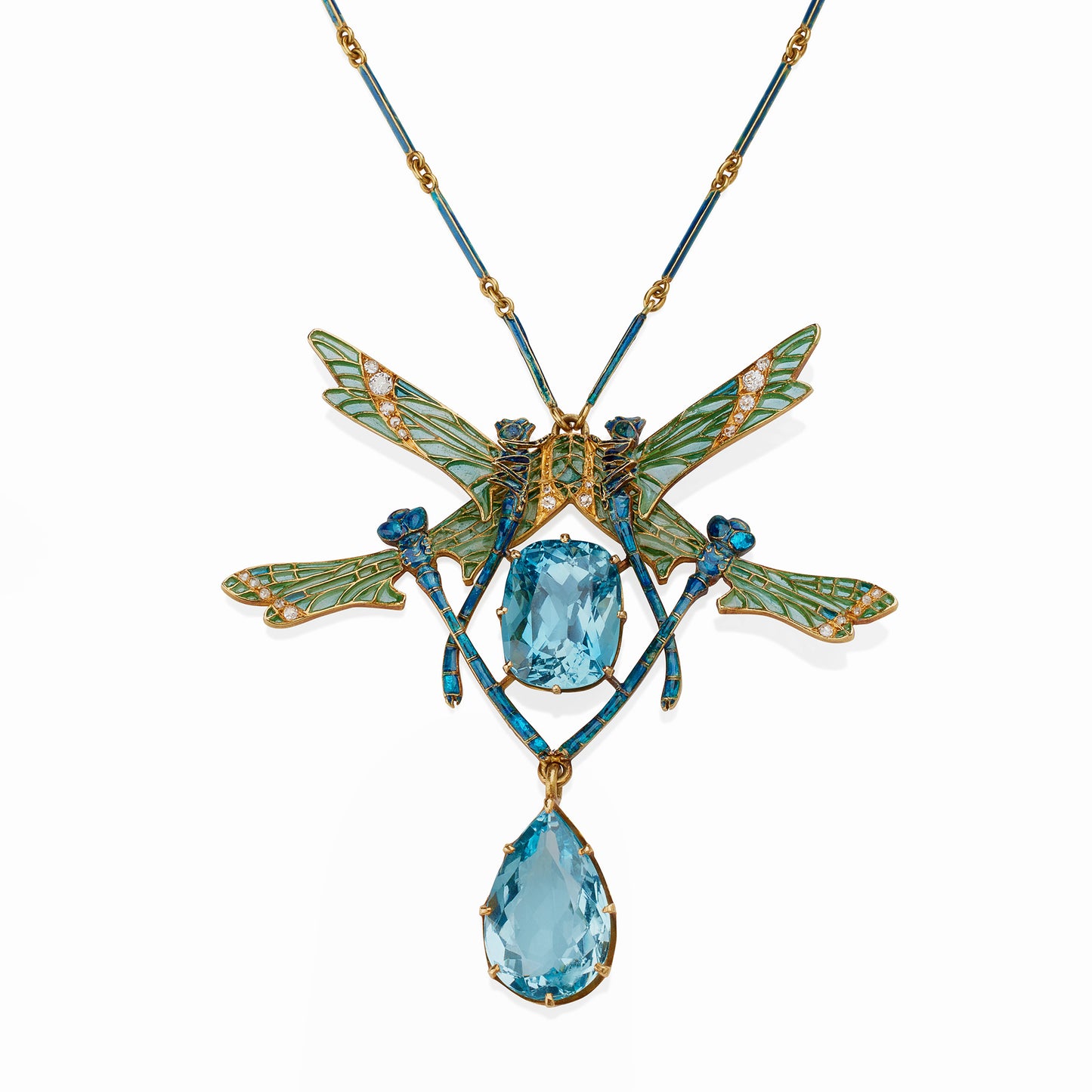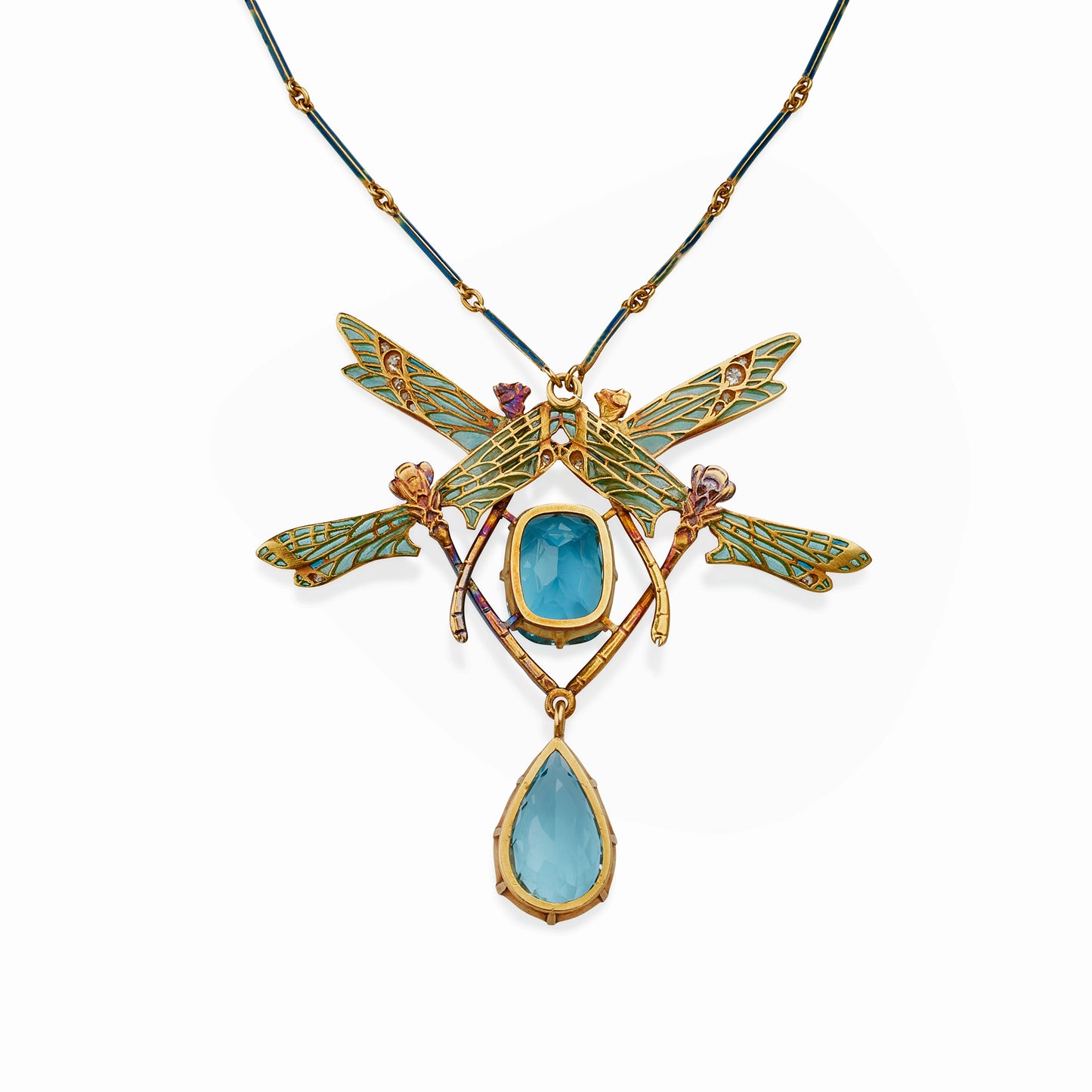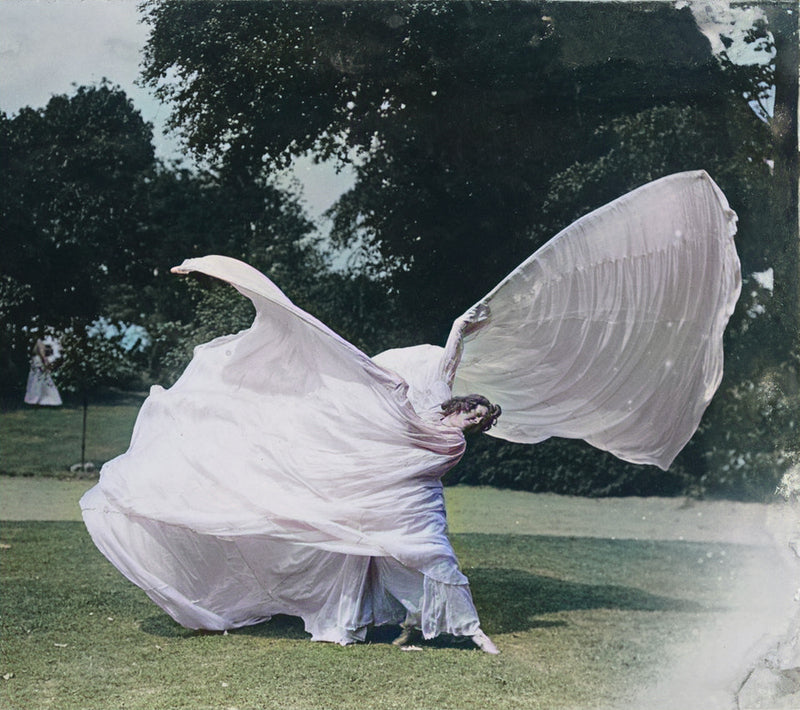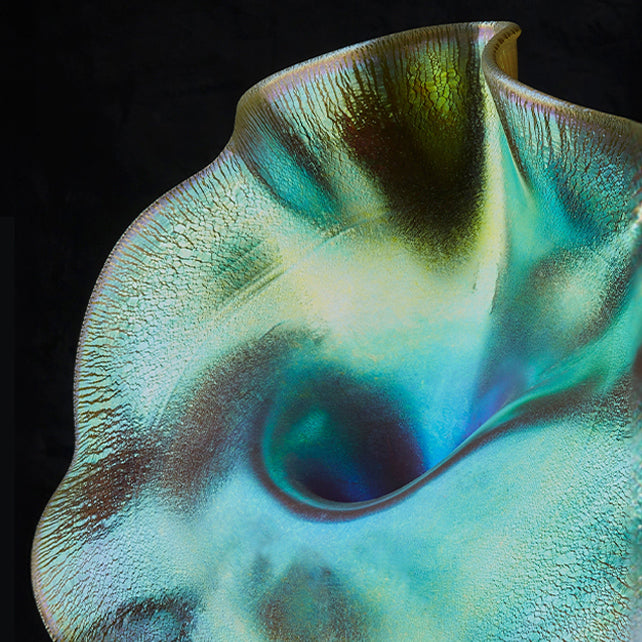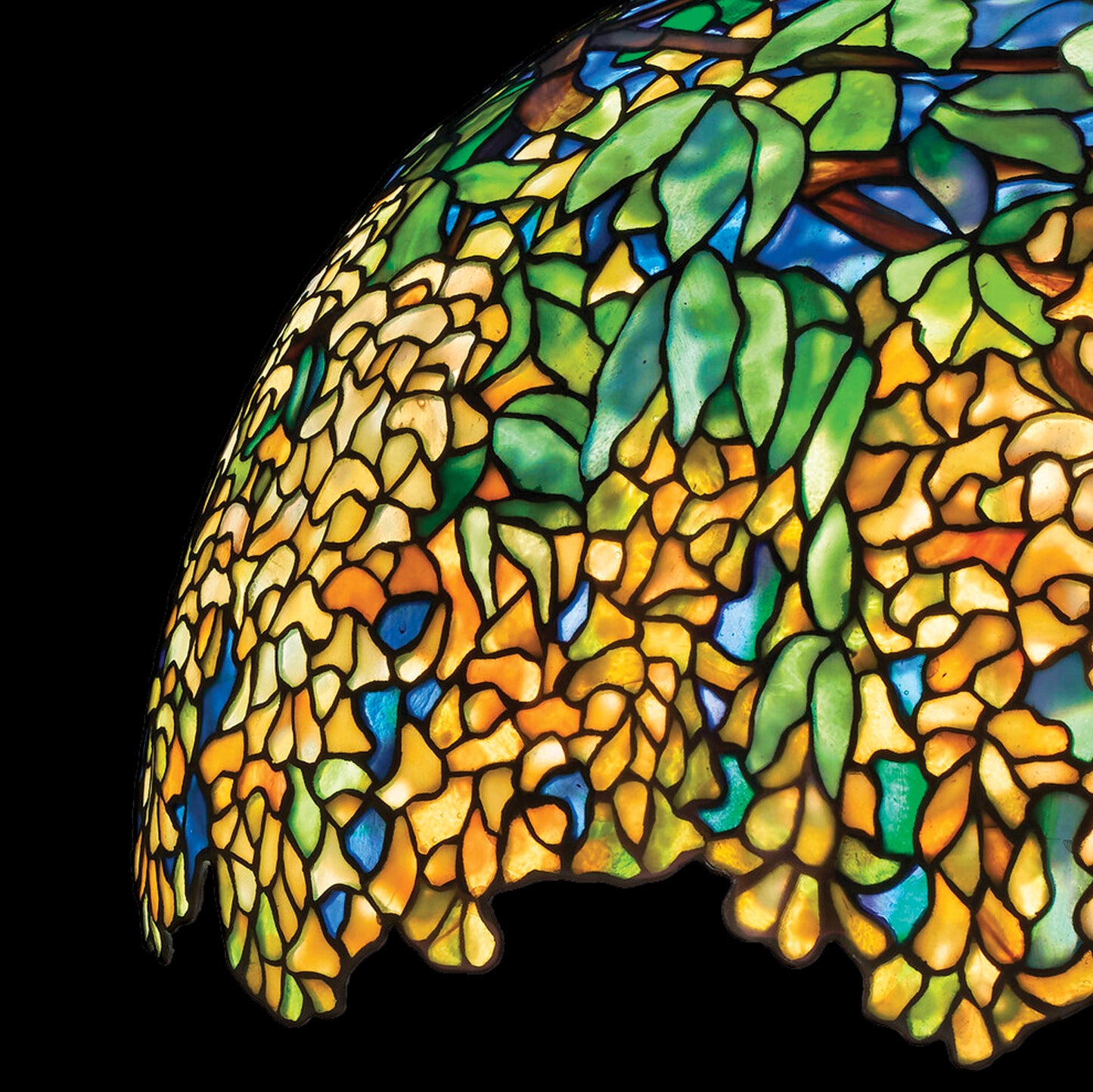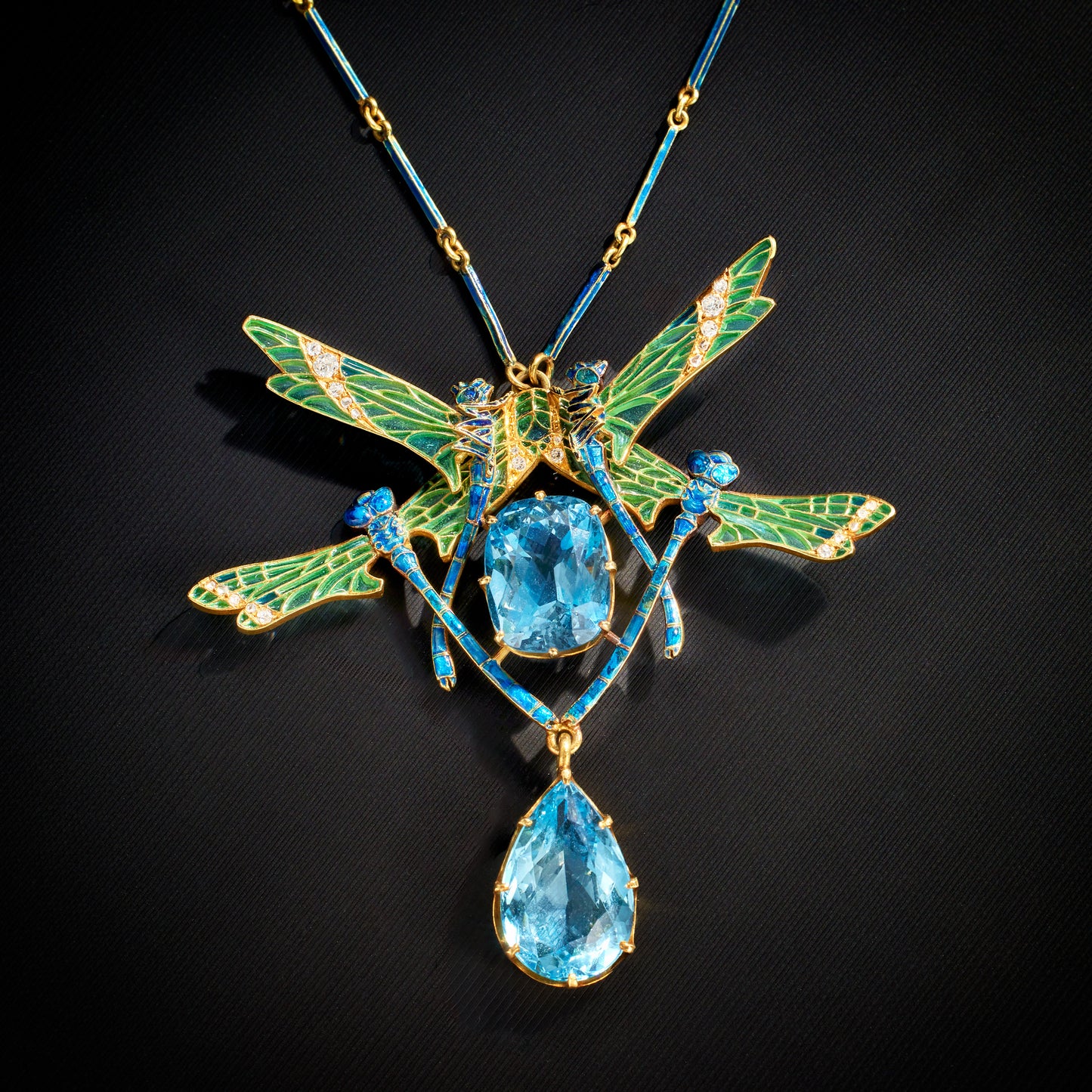René Lalique "Four Dragonflies" Pendant Necklace
Item #: N-21372
Artist: René Lalique
Country: France
Circa: 1903-04
Size: Pendant: 2.5" x 2.5", Chain: 19"
Materials: 1 pear and 1 cushion-shape aquamarine; 24 rose, old single and old European-cut diamonds (approximate total weight 0.25 carat); Enamel; 18K Gold
Signed: LALIQUE
Literature: The design for this jewel executed in pencil, ink and opaque wash on yellow-brown parchment, and numbered 181, is pictured in "René Lalique 1890-1910 Schmuck und Objets-d'Art", the catalogue raisonné by Sigrid Barten, p. 730.
Item #: N-21372
Artist: René Lalique
Country: France
Circa: 1903-04
Size: Pendant: 2.5" x 2.5", Chain: 19"
Materials: 1 pear and 1 cushion-shape aquamarine; 24 rose, old single and old European-cut diamonds (approximate total weight 0.25 carat); Enamel; 18K Gold
Signed: LALIQUE
Literature: The design for this jewel executed in pencil, ink and opaque wash on yellow-brown parchment, and numbered 181, is pictured in "René Lalique 1890-1910 Schmuck und Objets-d'Art", the catalogue raisonné by Sigrid Barten, p. 730.
When the category of “minor arts” was introduced into the Paris Salon competitions, in 1895, Lalique entered immediately and received a third place prize for a “magnificent jewel with dragonfly motifs”. The dragonfly held a privileged place in his imagination throughout his artistic explorations in the medium of jewelry.
Lalique’s approach to jewelry united ideas drawn from several powerful movements in various artistic media, from painting and sculpture to poetry to music. Also, since the 1867 Exposition in Paris, exposure to Japanese art, aesthetics and craftsmanship had revolutionized Europe. Metalwork, enameling, lacquering and other decorative arts were transformed. Through the lens of Japonisme, Lalique expressed his passion for the flora and fauna of his native fields, streams and water meadows, especially insects, whom he termed his fellow “lovers of plants.” In his jewelry art, he expressed aspects of the traditional Japanese view of nature, which “excluded the idea of human superiority over other living things.”
An ancient symbol of Japan, “Land of the Dragonfly,” the “tombo” figures in their most ancient literature and origin myths, symbolizing victory and focussed endeavor. Its shape was likened to the form of the nation’s archipelago. Over the centuries, the dragonfly motif was ubiquitous in Japanese decorative arts, appearing in textile design and in metalwork, adorning the helmets of Samurai as a symbol of victory. Parisians, like Lalique’s fellow Art Nouveau jeweler Vever, eagerly collected Japanese art, and Lalique was familiar with their woodcuts, drawings and paintings. His imagination was especially informed by the illustrated books of insects by Kitagawa Utamaro (1753-1806).
Merging Japonisme with contemporary ideas about the essence of modernity, as expressed by Baudelaire, Lalique sought to "to distill the eternal from the transitory.” The dragonflies are captured alighting for a moment of stillness at the edge of a luminous pool of water, represented by a cerulean aquamarine. Their wings are illuminated in subtle gradations of color through the medium of plique-à-jour enamel. The tiny, fragile insects of marshes and waterways are offered as a powerful representation of this particular realm of nature. This jewel is a work of art serving as a “re-creation of a world”, a “Gesamtkunstwerk.”
The pendant necklace is a work of many hours, perfected by multiple expert artisans laboring on the fretting and chasing the gold mount, executing two challenging types of enameling, and setting the diamonds and aquamarines, all their efforts performed under the exacting direction of the artist himself.
When the category of “minor arts” was introduced into the Paris Salon competitions, in 1895, Lalique entered immediately and received a third place prize for a “magnificent jewel with dragonfly motifs”. The dragonfly held a privileged place in his imagination throughout his artistic explorations in the medium of jewelry.
Lalique’s approach to jewelry united ideas drawn from several powerful movements in various artistic media, from painting and sculpture to poetry to music. Also, since the 1867 Exposition in Paris, exposure to Japanese art, aesthetics and craftsmanship had revolutionized Europe. Metalwork, enameling, lacquering and other decorative arts were transformed. Through the lens of Japonisme, Lalique expressed his passion for the flora and fauna of his native fields, streams and water meadows, especially insects, whom he termed his fellow “lovers of plants.” In his jewelry art, he expressed aspects of the traditional Japanese view of nature, which “excluded the idea of human superiority over other living things.”
An ancient symbol of Japan, “Land of the Dragonfly,” the “tombo” figures in their most ancient literature and origin myths, symbolizing victory and focussed endeavor. Its shape was likened to the form of the nation’s archipelago. Over the centuries, the dragonfly motif was ubiquitous in Japanese decorative arts, appearing in textile design and in metalwork, adorning the helmets of Samurai as a symbol of victory. Parisians, like Lalique’s fellow Art Nouveau jeweler Vever, eagerly collected Japanese art, and Lalique was familiar with their woodcuts, drawings and paintings. His imagination was especially informed by the illustrated books of insects by Kitagawa Utamaro (1753-1806).
Merging Japonisme with contemporary ideas about the essence of modernity, as expressed by Baudelaire, Lalique sought to "to distill the eternal from the transitory.” The dragonflies are captured alighting for a moment of stillness at the edge of a luminous pool of water, represented by a cerulean aquamarine. Their wings are illuminated in subtle gradations of color through the medium of plique-à-jour enamel. The tiny, fragile insects of marshes and waterways are offered as a powerful representation of this particular realm of nature. This jewel is a work of art serving as a “re-creation of a world”, a “Gesamtkunstwerk.”
The pendant necklace is a work of many hours, perfected by multiple expert artisans laboring on the fretting and chasing the gold mount, executing two challenging types of enameling, and setting the diamonds and aquamarines, all their efforts performed under the exacting direction of the artist himself.












